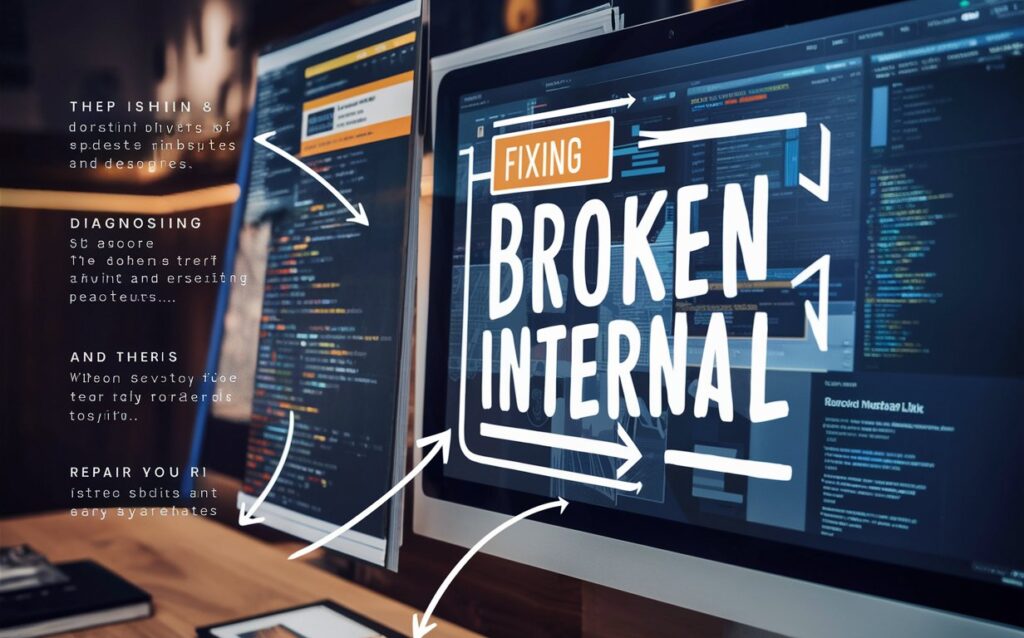To fix broken internal links, identify and update the URLs or remove outdated links. To automate the process, use tools like Screaming Frog SEO Spider.
Keeping a website’s internal linking structure in top condition is vital for both user experience and SEO performance. Broken internal links can frustrate visitors and hinder search engine crawlers from indexing your pages effectively. Web admins must regularly monitor their site for such issues to maintain a smooth navigation experience.
The onset of this task involves using dedicated software to scan the website for dead links. Once these problematic links are detected, the next step is to either correct the link paths or remove the links entirely if the destination pages no longer exist. It’s essential to prioritize this maintenance to preserve your website’s credibility and ensure optimal online presence.
The Impact Of Broken Internal Links
Broken internal links damage how search engines see your website. They could lead to lower rankings in search results. Search engines like Google value good link structure. When links don’t work, they can’t crawl your site well.
Users also need help with bad links, which can stop them from visiting your website again. Imagine clicking on a link for information you need, and it doesn’t work! This hurts your site’s reputation and user trust.
Identifying Broken Links
Spotting broken internal links is vital for website health. A great tool for this task is a site crawler. Tools like Screaming Frog SEO Spider or Ahrefs’ Site Audit can quickly find links that don’t work. Run the crawler, and it will list any issues you find. This way, fixing links becomes much easier.
Manual checks are also important. Look at pages with frequent updates. Check links in your top-performing content. It’s a hands-on way to ensure users find what they need.
The Role Of Redirects
Understanding the difference between 301 and 302 redirects is crucial for SEO. A 301 redirect tells search engines that a page has moved permanently, passing on most of the original page’s ranking power. On the other hand, a 302 redirect is for temporary changes. It signals that the move is not permanent, keeping the original page’s ranking intact.
For effective redirecting, always use 301 redirects for permanent moves. This helps in maintaining SEO value. Remember to update your sitemap and notify search engines after implementing the redirects. Regularly check for broken links using tools like Google Search Console. Redirecting properly ensures users and search engines find the right page.
Correcting Link Destinations
Fixing broken internal links is crucial for website health. Editing URLs may sound daunting, but it’s simple. Double-check each link. Ensure URLs point to the correct pages. Regularly audit links to keep them fresh and functional.
Maintaining an updated site structure prevents link rot. Use a reliable tool to identify broken links. Correct links swiftly to improve user experience. Smooth site navigation boosts SEO rankings.
| Action | Benefit |
| Check and fix URLs | Ensures accurate destinations |
| Regular link audits | Keeps links updated |
| Fast corrections | Enhances site usability |
Implementing An Audit Routine
Ensuring your website’s health involves routine checks for broken internal links. Create a schedule to audit your site regularly. Experts recommend a monthly or quarterly audit. This helps to catch issues before they affect user experience or SEO rankings.
Begin with a comprehensive list of all site URLs. Include both the destination and anchor text for each link. Use tools like Screaming Frog or Google Search Console. These tools make the process easier and more accurate. Your checklist should also cover different page types. Pages include articles, product pages, and more. Each type might have unique link structures. Regular check-ups maintain site integrity and performance.
Tools For Managing Internal Links
Keeping track of your site’s internal links is key to a healthy website. Link management software helps with this task. Tools like Ahrefs, Screaming Frog, and Semrush are excellent choices. They can scan your site and report broken links. For those using WordPress, several plugins make managing links simpler. Two popular ones are Broken Link Checker and Link Whisper. They allow for quick fixes right from your dashboard.
Content Management Systems (CMS) also offer internal link solutions. Platforms such as Drupal, Joomla, and WordPress have built-in features that let you search and fix links without separate software. Always back up your site before making mass changes!
Educating Your Team
Training your team is key to preventing broken internal links. Regular workshops ensure everyone understands the importance of link health. Creating a simple style guide can offer clear instructions for link maintenance.
- Maintain a checklist for weekly link checks.
- Use tools like Xenu’s Link Sleuth or Screaming Frog SEO Spider to automate the process.
- Document procedures for fixing links quickly.
- Assign specific roles so team members can update links.
Empowering your team with the right tools and knowledge can ensure that they keep your website’s internal links in top shape. A style guide serves as an easy reference for your team to maintain consistency across your site’s content.
Preventative Measures For The Future
Ensuring your website remains free of broken links is crucial for a seamless user experience and SEO performance. Utilize automated link-checking tools to regularly scan your site for any broken links. These tools alert you when a link needs attention, allowing for timely fixes.
Scheduled checks should become part of your routine maintenance. Adopt tools such as Google Search Console or specialized software that can monitor and report link status. This proactive approach minimizes the risk of broken links.
Embrace link-building best practices to ensure long-term stability. Use descriptive, keyword-rich anchor text that aligns with the linked page’s content. Avoid connecting to unreliable sources. Always opt for credible, high-authority sites.
Frequently Asked Questions
How Do You Fix A Broken Internal Link?
Identify the broken link using a tool like Google Analytics or Screaming Frog. Update the link to point to the correct existing page or remove it if the destination no longer exists. Ensure to test the updated link for proper functionality.
How Do I Fix A Corrupted Link?
To fix a corrupted link, identify the broken URL, update it with the correct address, remove any invalid characters, clear the cache, and test the link to ensure it’s working properly.
How Do You Make A Broken Link Work?
To fix a broken link:
- Locate the correct URL and update the link’s destination.
- If the page no longer exists, create a redirect to a relevant page or remove the link altogether.
- Regularly check for and repair broken links to improve website usability and SEO.
How Do I Fix Internal Outlinks Without Anchor Text?
To fix internal outlines without anchor text:
- Review your website’s content and add relevant, descriptive anchor text to each link.
- Ensure the text is concise and accurately reflects the linked page’s content.
- Use a tool or manual check to find any missing anchor texts.
We can Help To fix Your all Broken Links
Conclusion
Ensuring your website’s internal links are intact is crucial for user experience and SEO ranking. By regularly auditing and repairing broken links, you can maintain a robust site structure. Don’t let link issues derail your traffic and engagement. Embrace these repair strategies to keep your digital presence strong and navigable.











